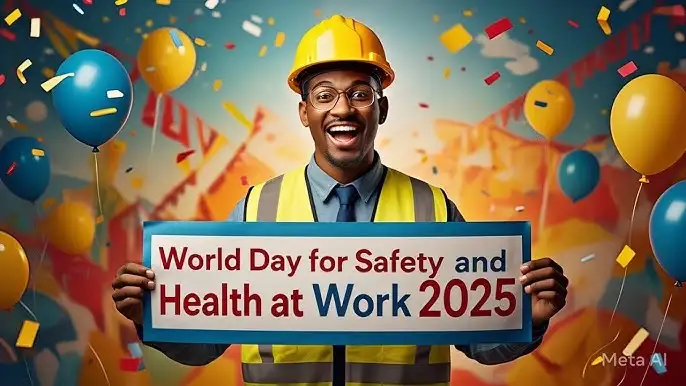World Day for Safety and Health at Work 2025: A Basic Right, Not a Privilege
Every year on April 28, people across the globe come together to recognize an important cause — ensuring every worker’s safety and wellbeing. The World Day for Safety and Health at Work isn’t just an event; it’s a powerful reminder that safe working conditions are basic rights for all, not luxuries for a few.

In 2025, this message rings louder than ever: safety at work is a basic right, not a privilege. As workplaces continue to evolve, protecting the health and wellbeing of employees remains a critical priority.
How It Started: The Story Behind the Day
The International Labour Organization (ILO) introduced this observance in 2003. They aimed to promote the prevention of workplace accidents and diseases worldwide. By dedicating a day to occupational safety, the ILO encouraged proactive steps to safeguard workers everywhere.
They chose April 28 deliberately, aligning it with the International Commemoration Day for Dead and Injured Workers. Labor unions started this commemorative day to honor workers who lost their lives or suffered injuries due to unsafe work conditions. This connection strengthens the meaning of the World Day for Safety and Health at Work: remembering tragedies while striving for better futures.
Theme of 2025: “A Basic Right, Not a Privilege”
This year’s theme, “A Basic Right, Not a Privilege,” highlights a critical truth: every individual, regardless of occupation, deserves a safe workplace. Health and safety shouldn’t depend on someone’s location or type of job.
Sadly, millions of workers across the globe still endure hazardous conditions without adequate protection. Whether on construction sites, in factories, or healthcare facilities, many face daily risks. The 2025 theme calls on governments, employers, and workers alike to recognize safety as an essential right rather than an optional benefit.
Why Workplace Safety Matters
Workplace injuries and illnesses extend their impact beyond the individual. Families, businesses, and communities also suffer. According to ILO reports, nearly 3 million people die each year due to work-related incidents and diseases. Millions more endure injuries that affect their ability to live and work fully.
The economic consequences are equally severe. Unsafe working conditions cost billions globally through lost productivity, medical bills, and compensation payouts. In contrast, investing in proper safety measures saves lives and strengthens economies.
When workers feel safe and valued, businesses see improved efficiency, morale, and loyalty. Safe workplaces ultimately fuel sustainable growth and prosperity.
How the World Observes This Day
Countries around the world organize a variety of initiatives to mark the World Day for Safety and Health at Work. Some key activities include:
- Awareness campaigns: Governments and organizations launch visual campaigns to emphasize safe work practices.
- Workshops and training sessions: Employers host events to educate employees about hazard recognition and prevention strategies.
- Policy discussions: Labor leaders and policymakers review safety regulations and propose necessary improvements.
- Memorial services: Communities gather to honor workers who lost their lives in the line of duty, ensuring that their sacrifices inspire ongoing change.
These observances aim to inspire lasting improvements rather than being one-time activities.
Building Safer Workplaces: What We Must Do
While observing this day matters, real change requires consistent efforts throughout the year. Here’s how we can build safer workplaces:
- Enforce strong laws: Governments must create clear safety standards and rigorously enforce them.
- Invest in training: Companies should provide regular education to help workers recognize risks and protect themselves.
- Provide reliable safety equipment: Employers need to supply proper gear and technology tailored to specific industry needs.
- Promote a culture of safety: Businesses should embed safety into their values, where everyone—not just managers—shares responsibility.
- Encourage open communication: Workers must feel empowered to report unsafe conditions without fear of retaliation.
When organizations prioritize prevention over reaction, they significantly reduce the risks workers face.
Looking Ahead: A Shared Responsibility
As we reflect on World Day for Safety and Health at Work 2025, we must recognize that creating safer workplaces requires a united effort. Governments, businesses, employees, and communities each play crucial roles in shaping healthier environments.
The modern workplace continues to evolve with technology, remote work, and new industries. However, the fundamental need for worker safety remains constant. Whether on a factory floor, a hospital ward, or in an office cubicle, every worker deserves to perform their job without risking their health.
When we treat safety as a right and not a privilege, we create stronger, more resilient societies.
Conclusion
Workplace safety is not just about rules and regulations; it’s about respect, dignity, and the right to return home unharmed every day. Observing the World Day for Safety and Health at Work reminds us that behind every statistic lies a human life—a parent, a sibling, a friend.
In 2025, let’s go beyond recognition and take real action. Together, we can build a future where every worker, no matter their job or location, enjoys the security and health they deserve—not as a special favor, but as a basic human right.






